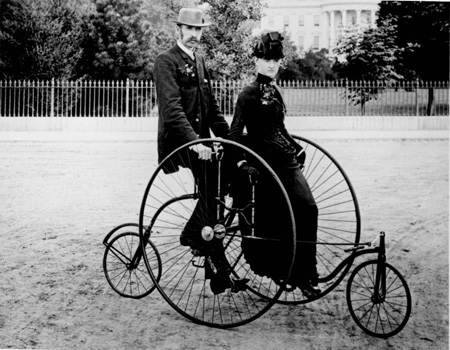Christopher Thompson and Fiona Ratkoff, “'A Third Sex'
Bourgeois Women and the Bicycle in Fin de Siècle France” (3)
Bicyles and Gender Anxiety
The doctors and hygenists favorable to the bicycle were quite aware that many of their compatriots feared that women cyclists menaced social stability. To calm these fears many doctors declared that the bycycle reinforced the family. Doctors Tissié and Lucas-Champonnière affirmed that cycling was a sport that the entire family could practice together. . . .
. . . the fact that mothers as well as well as fathers accompanied their children during educational rides in the French countryside demonstrated that the bicycle, even though it was reputed to strengthen the family, did so in a manner that increased the responsibilities and visibility of women at the heart of their families. . . .
However the tandem [bicycle] also suggested an equality between husband and wife that scarcely conformed to the social relations of the sexes at the core of the hierarchy consecrated by the bourgeoisie. At least one contemporary novel rejected the idyllic vision of the role of the bicycle in the strengthening of marriage and the stabilization of society. In the Maurice Leblanc’s novel, Voici des ailes!, published in 1898 ... two young married couples are so intoxicated by the sartorial, sensual, and sexual liberation ... that they have experienced on their bicycle trip that the women finished by riding with bare breasts and exchanging their husbands at the end of the excursion.
to the social relations of the sexes at the core of the hierarchy consecrated by the bourgeoisie. At least one contemporary novel rejected the idyllic vision of the role of the bicycle in the strengthening of marriage and the stabilization of society. In the Maurice Leblanc’s novel, Voici des ailes!, published in 1898 ... two young married couples are so intoxicated by the sartorial, sensual, and sexual liberation ... that they have experienced on their bicycle trip that the women finished by riding with bare breasts and exchanging their husbands at the end of the excursion.
. . . the bicycle continued to nourish the fears of those who were convinced that for women “even partial emancipation from her biological destiny will be a step towards the emancipation of her social destiny.” Cycling was a source of particular disquiet because, in addition to liberating the woman from her role in the home, it also encouraged the radical changes that were being produced in fashion at the end of the century. These alterations were all the more alarming because their essential element, pants, were apparently inspired by the trousers of men, a fact that numerous commentators of the period, both male and female, perceived as symptomatic of the chaos that menaced the cultural order of France at the end of the century. . . .
Social Control and the Crisis of Masculinity
As we have seen above, the doctors and hygenists had sought to justify by “science” the restrictions that they wanted to impose on feminine cycling. They tried to compel women to submit to gynecological exams, to restrict the distances they covered, as well as their speed, to limit the activity to those in good health, and to exclude those who were pregnant or who were having their menstrual cycle. Such restrictions were founded on widely accepted scientific interpretations concerning the “natural” inferiority of women, explanations whose appeal grew throughout the 19th century. The renewed search for scientific arguments to demonstrate the inferiority of women took place even though the system of the era’s highly hierarchical notions about the social relations of sex were being thrown into question, and the traditional roles and sexual differences were being contested, notably by women on bicyles. The belief spread that the more French women had power, the more their husbands and brothers would be dispossessed of their virility. The educational, professional, and legal progress of women contributed to the impression that the world “belonged” to them more and more, tendency which seemed to confirm masculine decadence, itself a symptom of a general national decline. The basic hypothesis seemed to be that France possessed a limited quality of virility. It followed logically that if women became more masculine, men must on their side submit to the inverse process of feminization, to become what Maurice Barrès named the “half-males.”